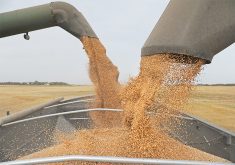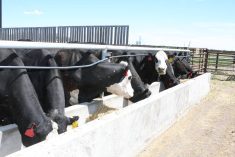Make changes this winter
This will be my last article for awhile as we’re off to Mesa, Arizona. Last year we went for one month, this year two. I wonder what next year will bring? I did promise myself to shape up before going back, in order to keep up with those much older than I on the hiking paths. However, it didn’t happen so I’ll have to pay the price.
A change of scenery will be my way of beating the winter blues. Any change adds variety, prevents boredom and cheers us up. Those staying at home might ask what they can do to add variety. Two suggestions are changing our meals or our homes.
Read Also

Agriculture productivity can be increased with little or no cost
There’s a way to enhance agricultural productivity with little or no cost. It doesn’t even require a bunch of legislative changes.
- Try new foods. Grocers have an increasing number and variety of food items on their shelves. For example, couscous, bulgar and rice spaghetti were new to me and now they add variety to the foods we enjoy.
- Try new recipes. Take time to look through recipe books and magazines, jotting down or clipping out recipes to try. It is always surprising how long the list will get.
- Each day write on a calendar your family’s menu for that day. At the end of a week or month, exchange this with a friend.
- Have family members choose the menu for their birthday or for a specific day of the week.
Rearrange your home’s accessories.
- Accessories may mean almost everything in the room except furniture – all the small things such as knick-knacks, collectibles, pictures, plants, mirrors and pillows. They may be purchased, handmade or items gathered from the outdoors.
- Gather all the small items. Rearrange them by setting them back in groups, in a few places. Grouping is important to give the accessories importance and to make the room look more spacious and less cluttered. A grouping of an odd number (three or five) is more pleasing to the eye than a grouping of an even number (two, four or six.)
- Weed out the collection from time to time. These extra items may be saved for a garage sale, given away or put away for awhile and brought out again in the future. It may seem like a new accessory in a year or two.
Accessories add color, texture and interest. They can do this for little cost. For example, a piece of driftwood picked up on a vacation will have special meaning as it brings back memories of the vacation, it will be one of a kind and of no cost. Accessories provide us with the opportunity to have fun with our ideas and creativity and to add variety in our lives.
Operation lifesaver
Each year, people across Canada, must face the reality that one of their loved ones has been killed or seriously injured in a collision at a rail/highway crossing. Just a moment of caution could have prevented these tragedies and the anguish they cause.
A national public education program called Operation Lifesaver helps Canadian motorists understand and avoid the dangers at railway crossings. It is a project of the Railway Association of Canada and Transport Canada, in co-operation with the Canada Safety Council and the provincial safety councils. To receive brochures and information contact your nearest provincial safety council or Operation Lifesaver, Suite 1105, 800 Ren-Levesque Blvd. West, Montreal, Que., H3B lX9, 514-879-8558.
Operation Lifesaver tells us there are:
- 24,000 rail/highway crossings in Canada.
- 400 rail/highway crossing accidents in an average year.
- 60 people killed in vehicle/train crashes in an average year.
- 250 hurt seriously enough to need medical attention.
Investigations consistently demonstrate that accidents happen when motorists are indifferent and negligent as they approach rail/highway crossings.
In 51 percent of the accidents, the drivers disregard the mechanical warning devices – bells they could hear, flashing red lights they could see, even watchmen who tried to flag them down. A third of the time the motor vehicle actually strikes the side of the train.
What we can do to prevent crossing crashes:
- Familiarity with rail/highway crossings breeds complacency. Most accidents occur within 40 kilometres of a driver’s home. Don’t fall into the trap of knowing a crossing too well and feel you know the schedule. Anytime is train time.
- Trains are big and powerful. They can’t stop on a dime. Travelling at 80 km/hour it takes about 2,500 metres for a train to come to a full stop. If it’s a race between you and the train, you lose. Don’t take a chance, it could be your last.
- Pay attention to all warning signs and devices. The standard “crossbuck” (X) sign is at all crossings in Canada. An ever-increasing number of crossings are equipped with flashing lights, bells and barriers. When approaching these crossings, slow down, check both directions and proceed only when it’s safe.
Driving around barriers or through the crossing when the warning devices are activated, is not only dangerous, it’s against the law.
- Remember, when there’s more than one set of tracks, there is a good possibility that after one train passes, another may be coming on another track.
- Railway tracks may be a tempting shortcut, but are dangerous and illegal. All railway property – including tracks, bridges, yards and equipment – is strictly off limits to trespassers. This includes all-terrain vehicle operators, trail bikers, snowmobilers, bicyclists, cross-country skiers and pedestrians.
- A train whistle sounding two long, one short and one long means STOP, a train is approaching. Federal regulations require that the engineer sound the train’s whistle. This signal of four blasts usually is started about 400 metres before the locomotive enters the crossing.
- Avoid stopping on tracks in a traffic jam. Wait on the approach until there is room for your car on the other side. If you stall on the tracks when a train is approaching, get away from your car immediately. Run toward, but not at, the train so you don’t get hit by flying debris.
- At night, be sure you can stop in time. Some drivers go so fast at night they can’t stop in the distance illuminated by their headlights. In about half of all night rail/highway crossing accidents, motor vehicles run into the side of trains.
- If you are driving across the tracks and the flasher lights start flashing and the gates are coming down, keep on going. It only takes a couple of seconds to continue across the tracks and the warning devices are activated several seconds before a train reaches the crossing.
Take time to stop, look, listen and live.
MSG information
Dear TEAM: I have been told that monosodium glutamates are harmful and that we should not eat foods containing them. Could you please tell me what MSG is and where it comes from and what it is made of? I have a sausage-making book that says it is not harmful and is made from beets. Please enlighten me. – R.S., Neilburg, Sask.
Dear R.S.: Monosodium glutamate is a salt that is made from glutamate acid, which is one of the most common amino acids found in nature. Glutamate is a major component of many protein-rich foods such as meat, fish and milk, as well as plants such as wheat, corn and sugar beets. Virtually every food contains glutamate. It is also produced by our bodies and plays an essential role in human metabolism.
Glutamates can be made into monosodium glutamate, MSG, a white, crystalline powder that has little taste of its own, but enhances and points up the flavor of foods. In the early 1900s, scientists isolated this flavor-enhancing ingredient in seaweed and other plants. Today, MSG is produced in many countries around the world from sugar cane or sugar beets, corn sugar or wheat starch. MSG contains only one-third the amount of sodium as regular table salt.
Consumption of MSG
Data from the United Kingdom shows that per capita consumption of MSG is four grams (less than one teaspoon) per week. American and Canadian estimates are similar. In Taiwan, the per capita consumption figures are much higher, averaging 21 grams per week.
The human body metabolizes glutamate added to foods in the same manner it metabolizes glutamate found naturally in many foods. For example, the body cannot distinguish between glutamates found naturally in tomatoes from added MSG in tomato sauce.
IS MSG a safe food additive?
In 1958, the U.S. Food and Drug Administration designated MSG as a Generally Recognized As Safe (GRAS) substance, along with many other common food ingredients such as salt, vinegar and baking powder. Because consumers continue to have questions about MSG’s safety, scientists over the last several years have done many studies and concluded that MSG is safe for the general population, including pregnant and lactating women, and children.
IFIC Review (International Food Information Council) Newsletter, Washington, D.C., Oct. 1995, states that: “Because MSG is one of the most intensely studied food ingredients in the food supply and has been found safe, the Joint Expert Committee on Food Additives of the United Nations Food and Agricultural Organization and WHO placed it in the safest category for food additives.
“Subsequently, in 1991 the European Community’s Scientific Committee for Food confirmed the safety of MSG. Based on the extensive scientific data, and in view of large normal dietary intake of glutamates, the committee determined that specification on an acceptable daily intake was unnecessary.
“Finally, the American Medical Association’s Council on Scientific Affairs, the National Academy of Sciences, as well as the U.S. Food and Drug Administration, have all determined that MSG, at current consumption levels, is safe.”
From all the testing and information available at the time, the conclusion is that MSG is a safe food additive.














